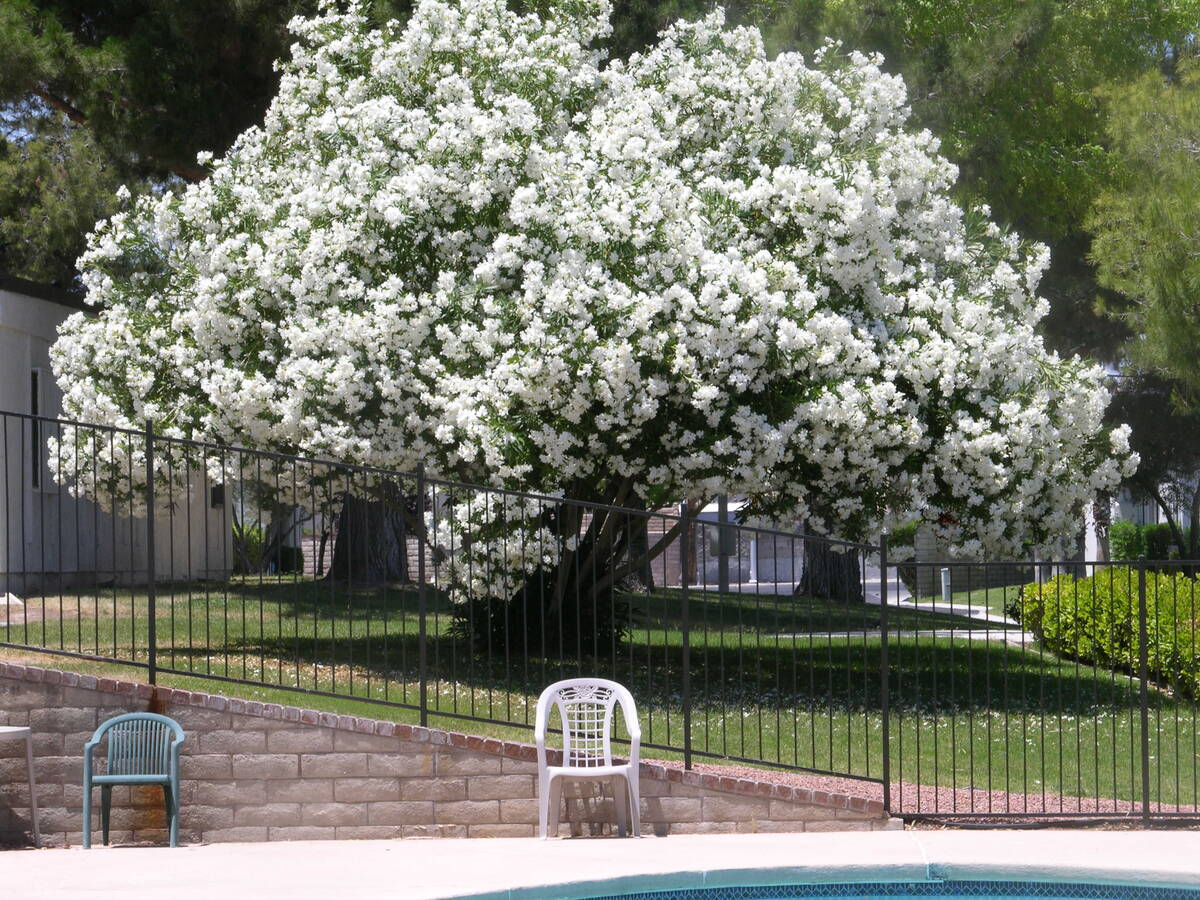Pruning oleander tree is only temporary fix
Q: I have a large old 40-foot oleander tree. Every year as it begins to flower, some of the leaves turn yellow and drop. I realize I may need to fertilize, but I was also thinking of cutting the trunks at about 20 feet, just below where it branches to encourage new healthier growth. Do you think this is an option? Obviously, I would do it in late summer when flowering has finished.
A: It’s a temporary fix. There is such a thing as root-to-shoot ratio. What that means is that the top of the tree returns to its pre-pruning height as quickly as possible. It’s because of the size of the roots.
The energy for growth is funneled into the top of the tree because the roots are at a maximum size for its height. Once the tree catches up to the size of its roots, it will slow in its growth because its nutrients for growth are partitioned once again.
Your oleander needs more water as the summer approaches: four times more from winter to summer and even more as it gets bigger. You can add more water without increasing the minutes by adding or changing drip emitters.
But the nice thing about most oleanders is that they handle desert heat well, unlike some other trees that get bigger. Oleanders are Mediterranean trees in their water use, not desert trees.
We have found that giving a tree, growing in a moat 6 feet in diameter, about 2 inches of water gives it enough water until its next irrigation. The difference in water use of plants from winter to summer is about four times.
The number of times that is done in a week or month depends on the time of year and whether it is a desert tree or not. At that size, if enough water is applied — so that its roots are wet to a depth of about 24 inches — it will last until the next irrigation.
What I can’t tell you is how many minutes that takes with drip irrigation. That needs a gallons-to-minutes conversion.
In Las Vegas, mesic (nondesert) trees are watered about three times a week in the summer. In the winter they are watered a week or 10 days apart, or about four times as long as during the summer months.
When changing the irrigation time, focus more on the number of days per week or month rather than the minutes of applied water. It is too confusing. The number of minutes to water is seldom changed with a seasonal change in watering.
Q: What are those “white fuzzies” on the stems of tomato, peppers, beans and even outdoor landscape plants?
A: These are planthopper or leafhopper egg masses. Planthoppers and leafhoppers are basically the same insect. The female lays her eggs on the surface and then covers them with a whitish, waxy fuzz.
You never see immatures because they drop to the ground from the eggs, much like cicadas. You only see weak-winged adults like the grape leafhopper. The only times they cause plant problems are when there are lots of them (grape leafhoppers) or when they send viruses and bacteria such as those that cause Pierce’s disease.
When these immature forms hatch from these eggs, they even look like very tiny cicadas. If you did see the immature forms without a magnifier’s help, you might mistake them for flies. Once in the soil, they feed on plant roots until they are adults and need to reproduce.
Q: My neighbor’s tree is sending out suckers that go under my cinder block wall and come out in my planter. I try to pull them out and spray them with a weed killer but to no avail. Is there anything I can do to keep them from coming up? I have the same problem in the front yard, but it’s the neighbor’s palm trees and seeds. They root in the front yard. Anything I can do to kill them too?
A: Actually, these are two separate problems. The palm seedling cure is the easiest to fix.
Pull palm seedlings out when they are about 8 to 12 inches tall. It works best in wet soil after irrigation.
Palm seedlings will die if the bud at the top of the plant, the terminal bud, is removed or killed, but it leaves the rest of the plant, which can be unsightly.
There are sprays that will kill the plant. They are sold as woody brush killers, but they must be sprayed only on the problem areas.
The first problem requires more work on your part. There is no spray, but you will have to remove the planter, remove or cut the roots that are suckering, put in a physical root barrier and then put everything back.
Q: I wanted to ask about a strange occurrence in my tomato garden. Not all, but some of my tomatoes that ripen have these black spots only at the bottom of the tomato crop. I just wanted to reach out and see if you could tell me about what causes or could be causing the discoloration.
A: That is normally a physiological problem on tomatoes, peppers and some eggplant this time of year called blossom end rot. Some scientists claim it is caused by an imbalance of calcium in some fruit when soils are cooler.
Sometimes calcium sprays can fix it. Some varieties of tomatoes show this problem more than others. This imbalance of calcium in other plants is called “bitter pit” in susceptible apples such as Mutsu and “corky spot” in susceptible pears such as Bartlett.
Apples and pears take regular leaf sprays of calcium as a temporary fix in them. The easiest way to fix this problem in tomatoes is to use a less susceptible variety to blossom end rot. Otherwise, it may take several sprays of a liquid calcium spray (such as calcium chloride or calcium sulfate mixed in water) to fix it. The fruit is OK to eat, it just looks odd.
Q: Was it the western fence lizards that took up residence in our yard two or three years ago that ate our tomatoes? Or was it been something else? The lizards really keep ants down. Thoughts?
A: My understanding is that the western fence lizard is mostly a meat eater (ants, roaches, spiders) and not a vegetarian (your tomatoes), but I could be wrong. I thought the damage could be rats or rabbits (omnivorous and gnawing damage, my first thought) or birds like the boat-tailed grackle (vegetarian and pecking damage).
Sometimes fruits like tomatoes will ripen ahead of time if they are damaged first. I would rely on the fact tomatoes are climacteric fruit — they will ripen off of the vine if they are kept at room temperature for a few days — and avoid the problem and harvest them while they are still green but starting to ripen.
The fruit turns from a darker green to a lighter green as part of the ripening process. If this is an animal problem, they are sensing ripening fruit and either smell this or see it.
This may not be an animal problem at all. It might be best to stay ahead of the problem instead of trying to figure it out.
Q: I see palm trees with the fronds falling off all around our Sun City MacDonald Ranch on our daily walks. Was wondering if this is part of the palm’s life cycle or is it a disease problem?
A: Some palms have fronds that drop from the tree and other palms don’t. The usual dropping of fronds may or may not be typical to some palm trees like the Mexican fan palm. It depends.
It’s a genetic issue. Seed production in palms is from the wind, not from bees or flies. There can be a lot of genetic variability when starting plants from seed. In other words, there is a lot of variation in palms because they are started from seed. There is such a thing as seeded varieties (some lawn grasses) but for the most part not in
Mexican fan palms are typically started from seed. Mexican fan palms are famous for self-skinning. There is a lot of variability in that feature of Mexican fan palms. What you are seeing is genetic variability in these palms because of the seeds.
Palm fronds separate from the trunk because of rotting (rotting diseases), but this does not happen as often with California fan palms. These typically have a fatter trunk that holds on to the palm fronds and may form a skirt of old dead fronds that cling to the trunk. So, we call fan palms with a fatter trunk California fan palms and those with a skinny trunk Mexican fan palms.
Bob Morris is a horticulture expert and professor emeritus of the University of Nevada, Las Vegas. Visit his blog at xtremehorticulture.blogspot.com. Send questions to Extremehort@aol.com.





























